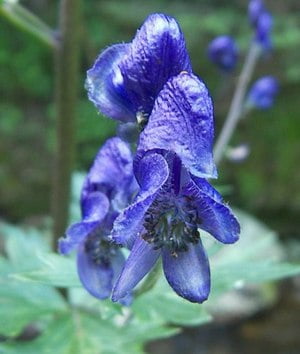A plant may be called an herb; however, that does not mean that you should add some to your salad or brew up an herbal tea to cure what ails you. Some herbs, despite the fact that they may have a history of having been used as medicinal and/or culinary herbs, are actually quite toxic and should not be used for either purpose. Such an herb is aconite (Aconitum napellus), commonly known as monkshood or wolf’s bane.
In Greek mythology, aconite was said to have grown on the hill of Aconitus. It was here that Hercules fought with Cerberus, the three-headed hound that guarded the entrance to Hades. Saliva from Cerberus was supposed to have fallen on the plant, causing it to become poisonous. This highly toxic herb was later used by hunters, who would put it on the tips of their arrows prior to hunting for wolves, consequently the name wolf’s bane. European and Asian soldiers would drop it in the water supplies of their enemies, and witches would combine it with another poisonous herb – belladonna – to create an ointment supposedly enabling them to fly. (Of course, it was probably just in their heads. Aconite can cause mental confusion.)
In spite of its toxicity, aconite was used as a medicinal herb. Aconite liniment was used to alleviate pain, especially pain caused by arthritis and rheumatism. When applied to the afflicted area, there would first be a hot, tingling feeling followed by numbness. The Chinese still use aconite in various drugs, but you should not think that you can do the same at home. The amounts used are carefully measured and infinitesimal, and a pinch too much can be lethal. (A mere 5 milliliters of a tincture is all that is needed to bring about an untimely demise.) Personally, I would steer clear of any herbal remedy containing even the smallest amount of aconite. You should do the same.
You will, however, probably see aconite for sale in nurseries and greenhouses under its common name monkshood. The name comes from the shape of the deep purple or violet-blue flowers. The upper petal or sepal forms a hood that fits over the top of the rest of the flower. (There are also white and mauve varieties available.) The tag accompanying the plant will generally tell you that the plant is a perennial hardy in Zones 2-7. It will also tell you that you need to plant it in rich, moist soil in full sun to partial shade. What the tag probably will not tell you is that you should use care when planting and caring for your monkshood or aconite. You should not plant aconite if there is a chance that small children could get into it. If you do decide to plant it in your perennial garden, make sure you wear gloves. The entire plant is toxic, especially the roots. The alkaloids that are the source of the poison can be absorbed into the skin, resulting in aconite poisoning. Symptoms of aconite poisoning include: slowed pulse, tingling, vomiting, sweating, frothing, confusion, dizziness, headache, blurred vision, motor impairment, shallow breathing, alternating cold and burning sensations, and paralysis.
Now that I have told you about all of the bad things that aconite can cause, you are probably wondering why I would even hint that you plant it in your garden. The reason is that aconite is actually a beautiful plant for the perennial garden. It grows to be 2-4-feet tall, making it good for the back of the border. It produces its distinctive flowers in the late summer and fall, giving color to the garden when many of the spring/summer perennials are starting to fade. Its dark green leaves have a delicate appearance, actually looking a lot like parsley. (Some people have accidentally been poisoned by aconite thinking that it was parsley. The roots also look like horseradish.) If handled and planted with care, you will love the effect that it has in your flower garden. Just remember that it is for your garden and not for your dinner plate or for any herbal remedies.
References:
Kowalchik, Claire and Hylton, William H., eds. Rodale’s Illustrated Encyclopedia of Herbs. Emmaus, PA: Rodale Press, 1998, pp. 1-2.
Kruger, Anna. An Illustrated Guide to Herbs, Their Medicine and Magic. Surrey, Great Britain: Dragon’s World Ltd., 1993, p. 20.
Wrong Diagnosis. Monkshood poisoning.
